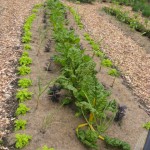Last week my friend Steve suggested that we might enjoy spending Sunday at the Tower Hill Botanic Garden in Boylston . . . and we did. Around 10:30 this morning, we met up in Sturbridge and drove from there via the Pike, 290, 140 and 70 to 11 French Drive. Although the day remained cloudy, it didn’t rain, and the temperature was actually quite comfortable for walking around these 132 acres of gardens, meadows, and woods.
Incorporated in 1842 “for the purpose of advancing the science and encouraging and improving the practice of horticulture,” the Worcester County Horticultural Society owns and operates the Botanic Garden; on 25 September 1988, a 50-year master plan for developing the property was unveiled to the public. Many organizations, including non-profits, construct 5 or 10 year master plans, but this one looks forward half a century. I’m quite sure I won’t be alive in 50 years, but I like to think that some of the trees and shrubs that I’ve seen today will be.
There are different types of gardens featured at Tower Hill, as well as miles of walking trails through a variety of habitats; we decided to try visiting all of them.
Adjacent to the Stoddard Education and Visitors Center is the Orangerie, an 18th century- style greenhouse. Winter-blooming temperate and subtropical plants are kept indoors in containers from October through May, then many of them are taken outside for the summer. You can see some of them in the thumbnail photo on the left.
Behind this building complex is the Systematic Garden, where plants in some 26 distinct families are displayed in groups according to a generally accepted scientific classification scheme based on evolutionary relationships. In the center thumbnail photo are species of monocots, one of the two major groups of angiosperms. I don’t remember what species of flower is featured in the thumbnail photo on the right; these flowers attracted a lot of pollinating insects though.



Heading north from the formal gardens is a short trail to the Belvedere, a lookout point featuring dramatic views of Mount Wachusett and the Wachusett Reservoir. As it was fairly cloudy, this was the best photo I could come up with. The trail continues up to the summit, the highest point on the property.
Back at the foot of the trail is Pliny’s Fountain, with Pliny’s Path leading east to the Inner Park, a landscape park which exhibits succession from fields to woodlands. This park also includes what I consider some bizarre sculpture; I thought I would post some photos so you could agree with me, but the area was shaded and all the photos were too dark to see much.
The trail out of the Inner Park leads to the Wildlife Refuge Pond and beyond that, to the “Birdhouse” and the Wildlife Garden, a wooded area where visitors can sit quietly and watch birds and animal life. The photo of the pond shows cattails and reflections of vegetation.
At noon today, the Rose Show opened to visitors in one of the exhibition halls. Although I don’t know anything about growing or judging them, I love roses and found the colors and scents enchanting. Here are a few that won some prizes.
South of the Visitors Center is the large expanse of the Lawn Garden, the first part of the original master plan to be implemented. It includes more than 350 species of trees and shrubs, as well as spring bulbs and summer perennials. I’m not sure the thumbnail photo on the left is one of these blooms but it does look like some sort of cultivar. The thumbnail photo on the right shows one of the sculptures in the Secret Garden, where we sat and ate lunch.


Our last stop of the day was the Vegetable Garden, adjacent to the 1727 Farmhouse. A huge variety of vegetables is grown here, and they all seemed to be flourishing, as these photos indicate. If I remember correctly, the produce is donated to a local food bank.


On our way out, we drove past the Harrington Orchard, which displays 238 trees of 119 heirloom apple varieties. We also saw some of the chestnut trees, genus Castanea, which botanists are trying to cross-breed into a disease-resistant strain.



